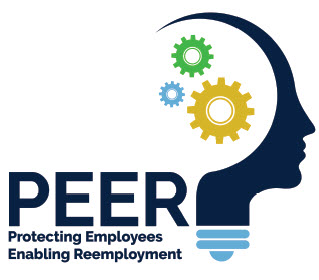Federal Employees Program

The Protecting Employees, Enabling Reemployment (PEER) Initiative serves as an opportunity for heads of federal departments and agencies to recommit to a safety- and health-conscious federal workforce—a workforce that can receive needed timely benefits through a modern and efficient workers' compensation system. The PEER Initiative supports the President's Management Agenda – Modernizing Government for the 21st Century, as well as the President's Initiative to Stop Opioid Abuse and Reduce Drug Supply and Demand.
In furtherance of this commitment, the PEER Initiative outlines seven areas in which federal agencies and the U.S. Postal Service are expected to improve or maintain performance:
- Reducing total injury and illness case rates;
- Reducing lost-time injury and illness case rates;
- Increasing the timely filing rate for workers' compensation claims (forms CA-1/CA-2);
- Increasing the timely filing rate for wage-loss claims (form CA-7);
- Increasing the rate of return-to-work outcomes during the initial 45-day post-injury period for traumatic injury cases (Continuation of Pay – COP);
- Improving the rate at which employees return to work in cases of moderate to severe injury or illness; and
- Implementing and fully using the U.S. Department of Labor's (DOL) electronic filing system, the Employees' Compensation Operations and Management Portal (ECOMP) by September 30, 2020.
ECOMP is DOL's self-service website for federal workers' compensation claims. It allows federal workers who are injured on the job to easily initiate a claim and route it to their supervisor for eventual submission to DOL. Fully using the ECOMP service will create a standard, effective, taxpayer-efficient experience for all injured federal employees instead of agencies funding their own claims systems, or continuing the cumbersome practice of faxing or mailing paper documents. Using ECOMP also allows critical immediate communication with injured workers about opioid and pain management education.
View the Secretary of Labor's memorandum to the heads of executive branch departments and agencies providing more information about PEER and its requirements, including a table of agency-specific targets.
PEER Documents
- PEER Interagency Meeting Presentation (3/17/2022)
- PEER Interagency Meeting Presentation (4/28/2021)
- Acting Secretary of Labor's Memorandum on PEER (03/15/2021)
- PEER Interagency Meeting Presentation (03/31/2020)
- Secretary of Labor's Memorandum on PEER (02/25/2020)
- Office of Management and Budget Memorandum Establishing PEER (01/09/2020)
PEER Performance Results
The pie chart identifies the 11 Agency/Departments with the largest case volumes (i.e., a total of 100 or more new serious injury cases measured for FY 2022) that are subject to Goal 6 and the number of forms they have submitted this fiscal year to-date. The "Snapshot" table below it displays a static year to date (YTD) performance under the PEER Initiative for those 11 Agency/Departments.
The "Additional PEER Goal Details" table below that is an interactive table, which can be used to provide more details on the performance of all agencies, sub-agencies, and different time periods. By default, it displays performance for the government as a whole for the fiscal year to date:
- Use the Agency filter to view the target and results for a particular Agency/Department.
You can then select a Sub Agency to view results at that level. Only the Agency/Department level will have targets. - You can filter by Fiscal Year and any given quarter or year-to-date results.
- Goals 1 and 2 only include the Executive branch (less the U.S. Postal Service).
- Goals 1 & 2 are end of year goals because the workers’ compensation total and lost-time cases data, used to calculate the rates for these goals, is cumulative. Therefore, the Quarter and Year-to-date data provided below for quarters one, two and three, are all projected end of year rates.
- Goal 6 targets/results are only tracked for the 11 Agency/Departments with the largest case volumes. All others will have 'N/A' for this goal.
- Goal 7 data displays the ECOMP filing percentage of the most recent month for the Agency and any of its Agency Groups created in ECOMP.
